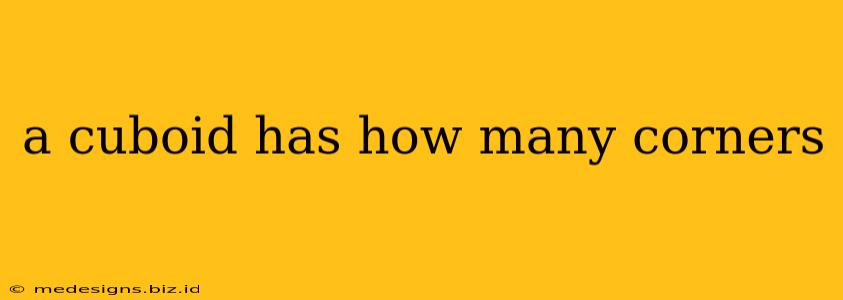A cuboid, a three-dimensional shape also known as a rectangular prism, is a familiar sight in everyday life. From boxes to buildings, understanding its basic geometry is key. One of the fundamental aspects of a cuboid is the number of corners it possesses. Let's delve into that and explore other key features.
How Many Corners Does a Cuboid Have?
The simple answer is: a cuboid has eight corners.
These corners are also known as vertices. Each vertex represents a point where three edges meet. Imagine a simple rectangular box; you'll find eight points where the edges converge – those are the corners.
Visualizing the Corners
To better understand this, consider these points:
- Top Face: The top face has four corners.
- Bottom Face: The bottom face also has four corners.
- Relationship: The corners of the top face directly correspond to the corners of the bottom face, creating a total of eight corners for the entire cuboid.
Beyond Corners: Understanding the Cuboid's Other Features
While the number of corners is a fundamental aspect, understanding other features enhances your geometrical knowledge. Let's explore:
Edges
A cuboid has twelve edges. These are the straight lines connecting the vertices (corners). Each edge represents the intersection of two faces.
Faces
A cuboid possesses six faces. These are the flat surfaces that make up the cuboid's exterior. Each face is a rectangle.
Why Understanding Cuboid Geometry Matters
Understanding the geometry of a cuboid extends beyond basic mathematics. It's crucial in various fields, including:
- Architecture and Construction: Designing buildings, rooms, and other structures necessitates a deep understanding of cuboid geometry and its spatial relationships.
- Packaging and Shipping: Optimizing the design and dimensions of packages for efficient storage and transportation is a direct application of cuboid geometry.
- Engineering: In numerous engineering disciplines, calculating volumes, surface areas, and spatial relationships relies heavily on understanding cuboids and other 3D shapes.
- Computer Graphics and Game Development: Creating 3D models and environments requires a comprehensive grasp of geometrical principles, including those related to cuboids.
In conclusion, a cuboid, with its eight corners, twelve edges, and six faces, is a foundational shape with broad applications across diverse fields. Understanding its properties is essential for success in various disciplines.
